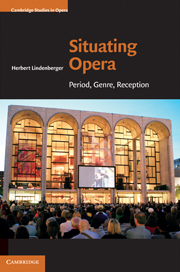Book contents
- Frontmatter
- Contents
- Acknowledgements
- Prologue
- 1 Anatomy of a warhorse: Il trovatore from A to Z
- 2 On opera and society (assuming a relationship)
- 3 Opera and the novel: antithetical or complementary?
- 4 Opera by other means
- 5 Opera and/as lyric
- 6 From separatism to union: aesthetic theorizing from Reynolds to Wagner
- 7 Toward a characterization of modernist opera
- 8 Anti-theatricality in twentieth-century opera
- 9 A brief consumers' history of opera
- Epilogue
- WORKS CITED
- Index
4 - Opera by other means
Published online by Cambridge University Press: 05 August 2011
- Frontmatter
- Contents
- Acknowledgements
- Prologue
- 1 Anatomy of a warhorse: Il trovatore from A to Z
- 2 On opera and society (assuming a relationship)
- 3 Opera and the novel: antithetical or complementary?
- 4 Opera by other means
- 5 Opera and/as lyric
- 6 From separatism to union: aesthetic theorizing from Reynolds to Wagner
- 7 Toward a characterization of modernist opera
- 8 Anti-theatricality in twentieth-century opera
- 9 A brief consumers' history of opera
- Epilogue
- WORKS CITED
- Index
Summary
Ten recent instances
Two Rodelindas
How do you find an appropriate means for staging an opera set in barbarous Lombardy during the supposedly darkest of ages (c. 700 ad)? Do you research what brutish clothes and crudely fortified buildings would have shaped these operatic characters' lives? But that would be too much the way of the nineteenth century, which wanted its theater and fiction to represent an earlier world “as it really was.” Or do you imitate the way that Rodelinda's parent play, Corneille's Pertharite, Roi des Lombards (1653), was likely staged, that is, in the elegant theatrical dress of the dramatist's own time? Or do you go to the equally elegant operatic dress, often Roman, but never medieval, prevailing at the time – 1725 – that Rodelinda was first performed? To be sure, the title character, sung by the famous Francesca Cuzzoni, wore what Horace Walpole described as a “brown silk gown, trimmed with silver,” that he pronounced “vulgar and indecorous,” though as he admitted, “the young adopted it as a fashion.”
Had there been a continuing performing history of Rodelinda, audiences would likely have settled happily for whatever setting had become customary by the end of the nineteenth century (doubtless a medievalizing one). But Handel's operas were not performed between his own lifetime and the early twentieth century – and, until a decade or so ago, only at the most sporadic intervals.
- Type
- Chapter
- Information
- Situating OperaPeriod, Genre, Reception, pp. 84 - 114Publisher: Cambridge University PressPrint publication year: 2010



